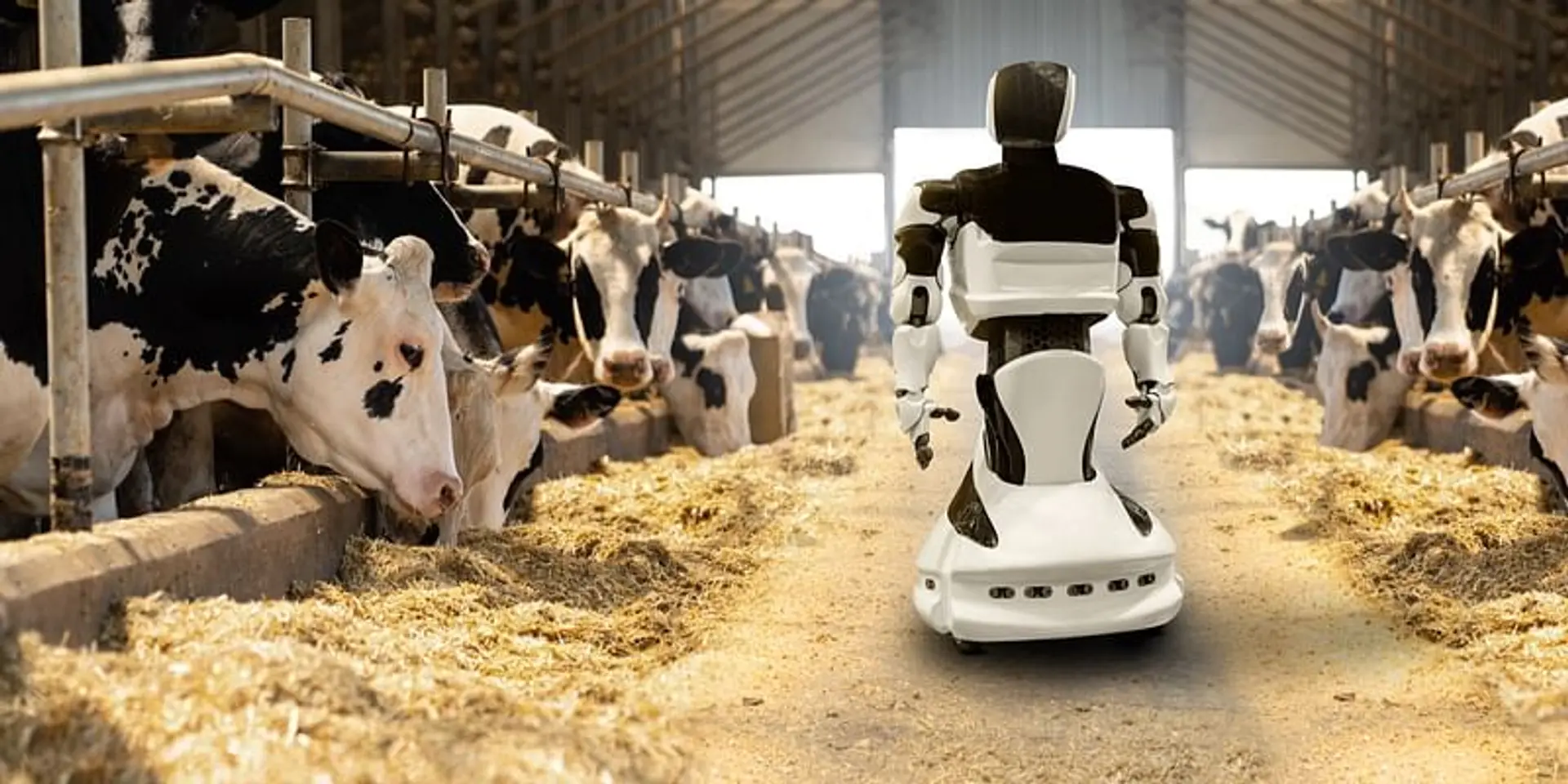From Bytes to Barns: A deep dive into AI-driven approach to animal nutrition and cattle farming
With the advent of AI, a transformative force is rapidly changing the agricultural landscape. AI's ability to analyse vast datasets, identify patterns, and make predictions is now being harnessed to optimise cattle farming practices.
Cattle farming, a cornerstone of agriculture for millennia, has traditionally relied on experience-based practices for animal nutrition and management. Feed rations are often standardised, disregarding individual needs, while health monitoring mainly involves visual observation. These methods, while effective to a degree, can lead to inefficient resource utilisation, animal health issues, and environmental concerns.
With the advent of AI, a transformative force is rapidly changing the agricultural landscape. AI's ability to analyse vast datasets, identify patterns, and make predictions is now being harnessed to optimise cattle farming practices. This article delves into the application of AI in animal nutrition and climate-conscious cattle farming, exploring its potential and challenges.
The intersection of AI and animal nutrition
Optimal health and productivity in cattle rely on a balanced diet, tailored to individual needs based on factors like age, breed, genetics, lactation stage, and environmental conditions. Traditional feeding practices often employ standardised rations, leading to over- or underfeeding, decreased efficiency, and potential health issues. AI offers cutting-edge tools for personalised nutrition management.
● Data Collection and Analysis:
Sensors worn by cattle can capture real-time data on activity levels, heart rate, respiratory rate, and feed intake. Additionally, weather data, feed composition analysis, and historical performance records can be integrated.
● Predictive Modelling for Nutritional Requirements:
Advanced AI algorithms analyse this vast data to develop personalised feed plans. Machine learning models predict individual nutritional needs based on various factors, enabling dynamic adjustments to rations, optimising nutrient absorption, and preventing overfeeding.
Case Studies: Success stories in AI-driven nutrition
A real-life example of a case study in AI-driven cattle farming is the project developed by Cainthus, an agtech firm based in Dublin. This project, known as ALUS Nutrition, uses AI to monitor cows in real-time, 24/7. The technology involves a smart camera system that continuously observes and analyses cow behaviour and feeding patterns.
On a Canadian farm, the ALUS Nutrition system revealed that cows were taking unusually short drinks. This observation prompted an investigation by the farmer, who discovered a stray electric current running through the water supply, which was negatively impacting the cows' milk production and overall health. By identifying this issue early, the farmer was able to rectify the problem, thus preventing a decline in milk production and maintaining the health of the cows.
Another case is the use of AI in Australian dairy farming. Researchers reported on AI systems that can automatically adjust the ambient temperature for dairy cows in a barn, or direct them to cooling systems with water sprinklers to mitigate heat stress. These systems assess individual cows and combine this information with weather data, allowing for automated and precise adjustments to the cows' environment. This innovation is expected to be feasible for implementation even by small and medium dairy farmers, demonstrating the accessibility and scalability of AI in livestock farming.
In India, eFeed excels in advanced animal management and nutrition through the use of artificial intelligence. They develop customised feed recommendations to boost animal productivity and reduce methane emissions, showcasing their dedication to both efficient production and environmental sustainability.
These examples highlight how AI technology in cattle farming not only enhances productivity and animal welfare but also addresses unexpected problems, leading to more sustainable and efficient farming practices.
AI in monitoring and managing cattle health
Early detection and treatment of diseases are critical for animal welfare and farm productivity. Traditional methods often rely on visual observations by farmers, with limitations in detecting early signs of illness.
AI is transforming cattle health management through:
● Wearable Sensors and IoT Devices:
Collars and ear tags equipped with sensors continuously monitor vital signs like temperature, heart rate, and movement patterns. AI algorithms analyse this data to identify deviations from normal ranges, potentially indicating illness.
● Image and Sound Analysis for Health Indicators:
AI systems can analyse images and audio recordings of cattle behavior, vocalisations, and body condition to detect subtle changes indicative of health issues. Early detection enables prompt intervention, minimising disease spread and improving animal welfare.
● Predictive Analysis for Disease Prevention:
By analysing historical data and current trends, AI can predict disease outbreaks. This allows for proactive steps like targeted vaccinations and environmental adjustments, preventing epidemics and safeguarding herd health.
Healthy animals are more productive. AI-powered health monitoring leads to timely interventions, reducing morbidity and mortality, and ultimately increasing milk and meat production, benefiting both farmers and consumers.
Climate-conscious cattle farming
Cattle farming significantly contributes to greenhouse gas emissions, land degradation, and water pollution. Methane released from enteric fermentation and manure management, coupled with deforestation for grazing land, are major concerns.
AI-Driven strategies for reducing carbon footprint:
- Precision Farming Techniques: AI-powered image analysis optimises pasture management, ensuring rotational grazing to prevent overgrasing and support healthier soil carbon sequestration. Precision irrigation based on real-time soil moisture data minimises water waste and promotes sustainable resource management.
- Resource Management and Sustainability: AI analyses manure composition and environmental factors to suggest optimal treatment methods, reducing methane emissions and generating valuable biofertilisers. AI-powered logistics optimisation minimises transportation emissions associated with feed delivery and animal transport.
Examples of eco-friendly farming practices
● In New Zealand, Halter develops AI-powered collars that track methane emissions, allowing farmers to identify high-emitting cows and implement breeding strategies to reduce overall herd emissions.
● In the US, Indigo Agriculture uses AI to analyse soil data and recommend optimised fertiliser usage, reducing nitrogen runoff and greenhouse gas emissions associated with fertiliser production.
The economic and social implications
While initial investment costs for AI technologies exist, studies show potential profitability gains. The Irish study by Cainthus mentioned earlier reported a 17% return on investment within two years due to feed cost reduction and increased milk production. Bridging the digital divide and providing adequate training are crucial for farmer adoption of AI technologies. Collaborative efforts between governments, research institutions, and extension services are necessary to support farmer education and address technology access barriers.
Policy and regulatory considerations
In terms of specific policies, the World Bank recognises the significant role of the livestock sector in global food systems and supports efforts towards making livestock practices more sustainable and equitable. The focus is on improving productivity while managing the adverse impacts on land, water, and the environment, and addressing the risks posed to animal and human health. This involves a careful balance between leveraging the opportunities presented by the growing demand for livestock products in middle- and low-income countries, and mitigating the sustainability issues associated with rapid sector growth.
In addition to these broader policy considerations, specific initiatives and programs are being implemented in various regions. For example, the World Economic Forum reports on initiatives like AI for Agriculture in India, which demonstrates a targeted approach to applying AI in specific agricultural contexts, addressing local challenges and needs.
Overall, the policy landscape surrounding the use of AI in agriculture and livestock farming is a complex and evolving field. It requires a systemic understanding of various factors, including environmental impacts, equity and accessibility issues, and the need for sustainable development in the sector. As AI continues to advance, it is likely that new policies and regulations will emerge to guide its responsible and effective implementation in agriculture globally.
Conclusion
Continuous advancements in AI algorithms, sensor technology, and big data analytics will fuel further innovation. Continued research in areas like personalised nutrition for individual animals, precision fermentation for alternative protein sources, and AI-powered breeding programs for climate-resilient cows holds immense potential for a more sustainable and efficient future of cattle farming.
(The author of the article is Mr Kumar Ranjan, CEO & Co-Founder, eFeed)
Edited by Megha Reddy
(Disclaimer: The views and opinions expressed in this article are those of the author and do not necessarily reflect the views of YourStory.)







